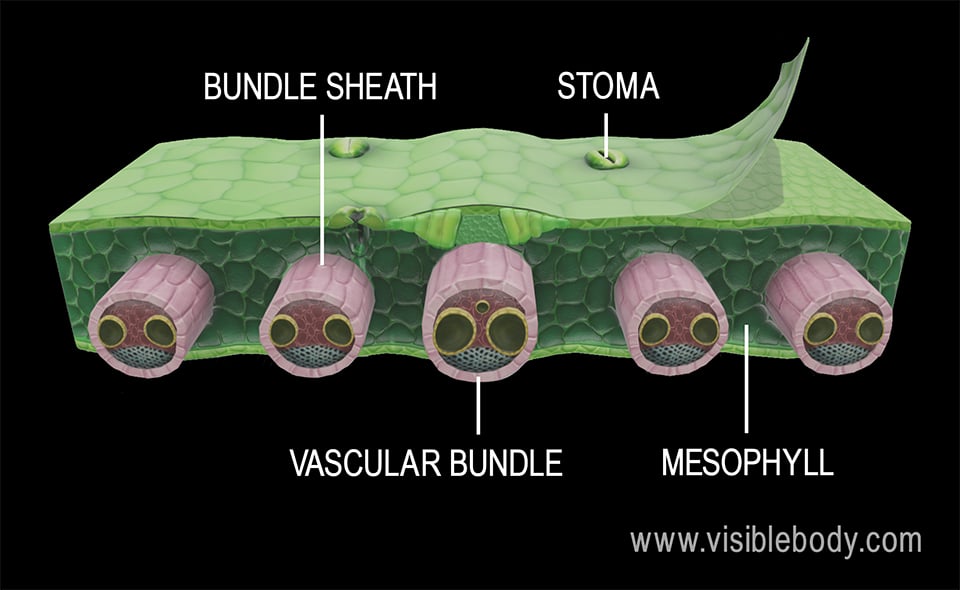
The leaves of flowering plants have an upper and lower surface, with the upper surface generally facing away from the ground and the lower surface facing toward it.
Leaf dermal tissue
Both monocot and dicot leaves have an outer, waxy layer called the cuticle that covers the dermal tissue of the upper and lower epidermis. The cuticle protects the leaf and helps it retain water. The epidermis, which is located beneath the cuticle, also protects the leaf. It plays a key role in gas exchange as well, because it contains pores called stomata. Stomata are also present in the plant’s stem and flowers, to some extent, but they are primarily a feature of the leaves.
The stomata allow carbon dioxide to enter the leaf and provide an avenue for water vapor and oxygen to exit the leaf. Each stoma is bordered by two specialized parenchymal cells, called guard cells. These cells open and close the stoma. When the turgor pressure in the guard cells is high, they bend outward, causing the stomatal pore to open. When the turgor pressure in the guard cells is low, due to a loss of water, the stomatal pore is closed.
Leaf ground tissue
A type of ground tissue called mesophyll fills the area between the leaf’s upper and lower epidermis. The cells in the mesophyll contain numerous chloroplasts, organelles that carry out photosynthesis, converting light, water, and carbon dioxide into sugar the plant can break down to generate energy. Oxygen is the main byproduct of photosynthesis—which is great for organisms like humans who need oxygen to breathe!
Leaf vascular tissue
In monocot and dicot leaves, vascular bundles are surrounded by one or more layers of parenchyma cells known as bundle sheaths. They protect the “veins” of the leaf. In monocot leaves, the cells of the bundle sheath carry out photosynthesis, but this isn’t always the case in dicot leaves.
Both types of vascular tissue have an important role to play in leaves. The xylem brings water and dissolved minerals up from the roots, and the cells in the mesophyll use the water when carrying out photosynthesis. Excess water is expelled through transpiration, the release of water vapor through the stomata. The phloem takes the dissolved sugars created by photosynthesis to the plant’s stem and roots to be used or stored.
Monocot leaves differ from dicot leaves in several ways. First, they tend to be more oblong or linear in shape, and their vascular bundles are organized into veins that originate at the base of the leaf and run parallel to one another. In other words, they have a striate venation pattern. There is usually only one leaf per node growing off of the stem.
Monocot leaves also have bulliform cells. These large, bubble-like cells, located just beneath the epidermis, are thought to help the leaf bend or fold. This is important because folding the leaf changes its exposure to light and the amount of water it retains.
Lastly, monocot leaves have stomata on both their upper and lower surfaces. Leaves like this are referred to as amphistomatous.
Dicot leaves are not as linear in shape as monocot leaves, and their vascular structures form net-like veins, instead of parallel ones. This reticulate venation pattern generally has one of two appearances. A leaf with a pinnated pattern (like a feather) has a central vein running down the middle of the leaf with other veins branching off to either side of it. A leaf with a palmate pattern has veins branching out from a single one to form a shape resembling the palm of a hand.
Typically, dicot leaves either have more stomata on the lower side of the leaf, or they have stomata only on the lower side of the leaf. Leaves with stomata only on the lower side are known as hypostomatous leaves. This arrangement of stomata allows dicot leaves to conserve water.
Dicot leaves (and a small number of atypical, “net-veined” monocot leaves) have two different types of mesophyll: palisade mesophyll and spongy mesophyll. Palisade mesophyll cells are located right beneath the leaf’s upper epidermis. They contain the highest number of chloroplasts of any cells in the plant, so they are optimized for photosynthesis. Spongy mesophyll is located below the palisade mesophyll. Its cells, which also contain lots of chloroplasts, are further apart than the cells of the palisade mesophyll. The loose-packed nature of spongy mesophyll allows gases to move through the tissue of the leaf more easily.
A microscope slide of a grass leaf with a description of bulliform cells from UTexas.
An article from the USDA detailing the differences between monocots and dicots.
When you select "Subscribe" you will start receiving our email newsletter. Use the links at the bottom of any email to manage the type of emails you receive or to unsubscribe. See our privacy policy for additional details.